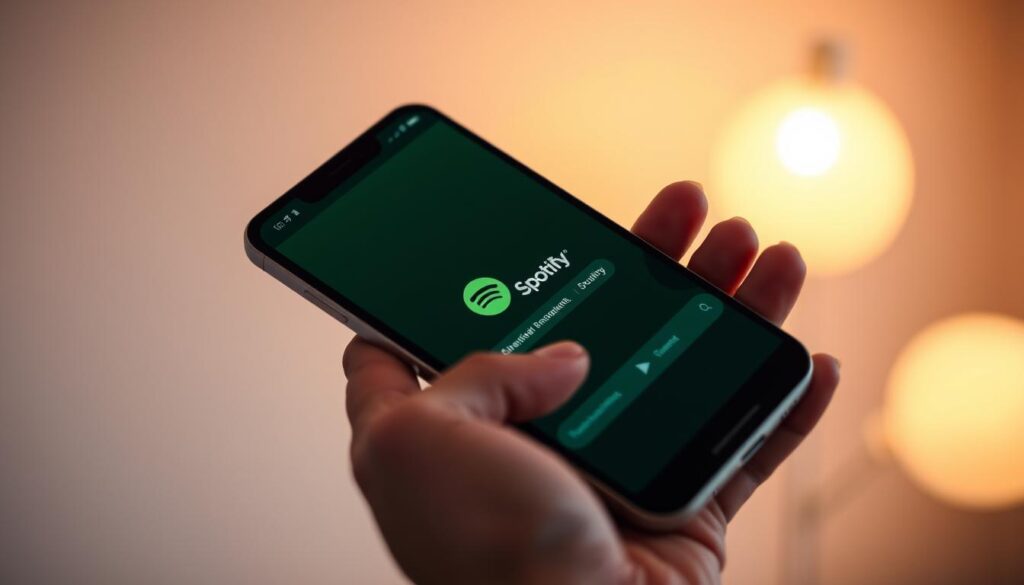Discover a new way to interact with your music and podcasts on Spotify using the latest voice-activated feature. By simply shouting “Hey Spotify” at your device, you can control every aspect of the Spotify app hands-free, making it perfect for multitasking.
This innovative feature is now available for the first time in the U.S. on both Android and iOS apps, with a broader rollout planned for the coming weeks. With this new capability, users can enjoy a more intuitive and effortless music discovery experience.
Key Takeaways
- Spotify’s new voice feature allows for hands-free control, enhancing the user experience.
- The “Hey Spotify” command provides direct integration with the Spotify platform.
- Voice commands are becoming essential for controlling playback without touching devices.
- This feature improves accessibility and convenience across both iOS and Android devices.
- Spotify’s voice search capability is part of its strategy to make music discovery more intuitive.
Understanding Spotify’s Voice Search Feature
Spotify has taken music discovery to the next level with its integrated voice search feature, ‘Hey Spotify.’ This innovative feature allows users to interact with the Spotify app in a more intuitive and hands-free way.
What is “Hey Spotify”?
“Hey Spotify” is a dedicated voice assistant built directly into the Spotify app. It enables users to control their music and podcast experience without needing to physically navigate through the app. To activate it, users can say “Hey Spotify” while the app is open or use specific shortcuts.
A key benefit of “Hey Spotify” is its ability to understand music-related commands and Spotify’s unique features without additional setup. The feature is designed to listen for the wake phrase in short bursts, immediately deleting audio if the wake word isn’t detected, thus addressing privacy concerns.
Why Voice Search Enhances Your Spotify Experience
Voice search on Spotify enhances the user experience by eliminating the need to navigate through multiple screens to find content, making music discovery more intuitive. It’s particularly useful during activities like cooking, exercising, or driving when hands are occupied.
- Voice search allows for hands-free control, making it easier to manage your music and podcasts.
- It understands contextual commands related to your listening habits, creating a more personalized experience.
- The feature is seamlessly integrated into the existing app interface, maintaining familiarity while adding new functionality.
How to Enable Voice Search Spotify
To unlock the full potential of Spotify’s voice search feature, follow these simple steps. Enabling “Hey Spotify” is a straightforward process that works across both iOS and Android devices.
Setting Up “Hey Spotify” on iOS and Android
To enable the “Hey Spotify” feature, open the Spotify app on your iPhone, iPad, or Android device. Tap and hold the “Search” tab until a prompt appears asking if you want to allow the app to listen for the “Hey Spotify” command. Tap the “Turn on ‘Hey Spotify'” button to proceed. You’ll then need to grant the app permission to use your microphone. Follow the prompts to allow microphone access and audio recording.
Accessing Voice Controls Without the Wake Word
If you prefer not to use the “Hey Spotify” wake word, there are alternative methods to access voice controls. You can tap and hold the Search tab to activate voice search. Another option is to use the microphone icon on the Search page.
Using the Search Tab Shortcut
Tapping and holding the Search tab provides a quick alternative to activate voice search without saying the wake phrase.
Using the Microphone Icon
The microphone icon on the Search page offers another convenient shortcut to activate voice search.
| Method | Description |
|---|---|
| Using “Hey Spotify” | Say “Hey Spotify” followed by your request to activate voice search. |
| Tapping and Holding Search Tab | Tap and hold the Search tab to access voice controls without the wake word. |
| Microphone Icon | Use the microphone icon on the Search page as another shortcut to voice search. |

To disable “Hey Spotify,” go to Settings > Voice interactions and toggle off “Hey Spotify.” This helps prevent accidental activations and is a smart move for personal privacy if you don’t use the feature frequently.
Mastering Voice Commands for Music Discovery
Mastering voice commands on Spotify can significantly enhance your music discovery experience. With the “Hey Spotify” feature, you can navigate through your favorite music and playlists using just your voice.
Basic Playback Commands
Using basic playback commands, you can control your music playback with ease. You can say “Hey Spotify, play,” “pause,” “skip tracks,” or “adjust volume” to manage your listening experience.
Creating Mood-Based Personalized Playlists
Spotify’s voice search allows you to create personalized playlists based on your mood. For example, you can say “Play an upbeat playlist” and Spotify will generate a custom playlist tailored to your listening habits.
| Voice Command | Action |
|---|---|
| “Hey Spotify, play my Running playlist” | Plays the specified playlist |
| “Hey Spotify, play Glass Animals” | Plays the specified artist |
| “Hey Spotify, play an upbeat playlist” | Creates a custom mood-based playlist |
Searching for Artists, Songs, and Podcasts
You can also use voice commands to search for specific artists, songs, and podcasts. This feature allows you to discover new music and access your favorite content without needing to remember exact titles.
By mastering these voice commands, you can enjoy a more personalized and seamless music listening experience on Spotify.
Conclusion: Enhancing Your Spotify Experience Hands-Free
Spotify’s latest innovation brings hands-free control to the forefront. With “Hey Spotify”, users can now enjoy a more streamlined music experience. This voice search feature simplifies music discovery, allowing users to find new songs, artists, and playlists with simple verbal commands.
The integration of voice commands within the Spotify app means users don’t need additional devices. It’s perfect for busy individuals and business professionals who need to multitask. By adjusting settings and using voice commands, users can customize their experience.
